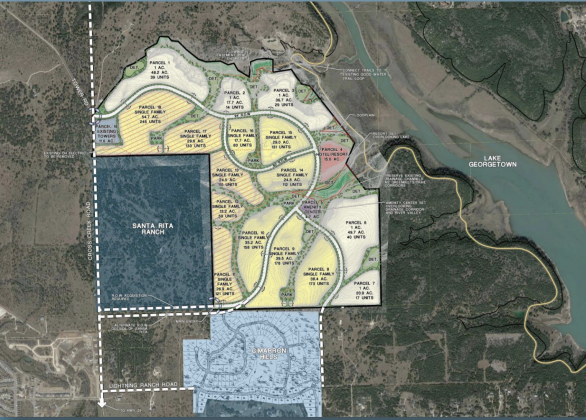Council members showed preliminary support for a new Municipal Utility District and its proposed land use in Georgetown’s extraterritorial jurisdiction during a Tuesday, June 27, city council workshop.
The proposed MUD, called Lakeside Estates, would make up almost 722 acres on the western side of Lake Georgetown and north of Santa Rita Ranch. The development would include 1,500 single-family homes, a 15-acres site for a resort hotel, 4.7 acres for an amenity center and 131 acres of open space, including 34 acres of public parkland.
The smaller single family lots would range from “40 to 80 feet,” while 145 units would be built on one-acre lots, according to the workshop presentation.
The ETJ is the area three miles outside of the city limits where the city has limited development oversight. ETJ residents do not pay city taxes and do not receive city services like trash and water. According to the city, the MUDs are used “to assist in closing the financial gap when a development is seeking to exceed minimum city standards, provide a robust program of amenities, and/or where substantial off-site infrastructure improvements are required.”
Because of the location of the proposed MUD, the developer, Zovest — which also built the Riverside Duplexes in Georgetown — requested a temporary “no-discharge wastewater package plant” to provide wastewater to the development during construction. The plant would be offline once the development is finished and it is able to connect to a permanent water system.
The temporary no-discharge wastewater package plant would reduce development costs.
Because of the lack of wastewater availability and the development's inability to use nearby Cimarron Hills wastewater service, the developers told council that, without a temporary plant, they would have to use wastewater resources that would add large expenses to the cost of the development.
The MUD site would border the Santa Rita Ranch neighborhood and has limited access to main roads. Because of this, county roads like Cross Creek Road and Lightning Ranch Road would be extended to give the development easier access to the surrounding areas. The developers said they already met with Williamson County commissioners, who were in favor of the road expansions funded by the developers.
All council members present at the meeting supported the idea of the MUD, but varied in their enthusiasm for the support for the temporary wastewater plant.
Amanda Parr, District 1 council member, said she only supported the idea because the developers said there are no other options to get wastewater to the development in a financially feasible way.
Council Member Ben Stewart, District 7, echoed similar sentiments.
“My only rub is really with the temporary package plant,” he said. “Although in general I don’t favor package plants, I think this is a thoughtful way to do it with the constraints you guys have, so I think this is a doable solution here.”
The preliminary development schedule presented to the council showed Phase 1 of construction starting February 1, 2025


